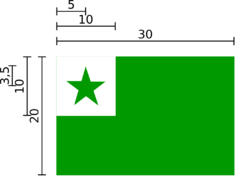Astronomy:Esperanto symbols
Esperanto symbols, primarily the Esperanto flag, have seen much consistency over the time of Esperanto's existence (namely in the consistent usage of the colour green), though a few variations in exact flag patterning and symbology exist.
The main flag of Esperanto, featuring the Verda Stelo ('Green Star'), was adopted in 1905 for use as a symbol of mutual recognition among Esperantists, and is used by most Esperantists. As an alternative to the flag, the jubilea simbolo ('jubilee symbol') has been more recently proposed (in 1987).
History
Verda Stelo
Since the earliest days of Esperanto, the colour green has been used as a symbol of mutual recognition, and it appears prominently in all Esperanto symbols.[1] In a letter to The British Esperantist in 1911, L. L. Zamenhof, the creator of Esperanto, wrote: "It seems to me, that my attention was drawn to the color green by Mr. Richard H. Geoghegan and from that time I began to publish all of my works with green covers . . . Looking at one of my pamphlets that I had entirely by chance printed with a green cover, he pointed out that this was the color of his homeland, Ireland; at that time it came to me, that we could certainly look at that color as a symbol of HOPE. About the five-pointed star, it seems to me, that at first Mr. de Beaufront had it imprinted on his grammar [of Esperanto]. I liked that and I adopted it as a symbol. Afterward by association of ideas, the star appeared with a green color."[2]
The Verda Stelo was first proposed in an 1892 article in La Esperantisto for use as a symbol of mutual recognition among Esperantists. The flag was created by the Esperanto Club of Boulogne-sur-Mer, initially for their own use, but was adopted as the flag of the worldwide Esperanto movement by a decision of the first World Esperanto Congress, which took place in 1905 in that town.
Other proposed flags and symbols
In 1905, delegates to the first conference of Esperantists at Boulogne-sur-Mer, unanimously approved a version differing from the modern only by the superimposition of an "E" over the green star. Other variants include that for Christian Esperantists, with a white Christian cross superimposed upon the green star, and that for Leftists, with the color of the field changed from green to red.[3]
Some Esperanto speakers[who?] consider the traditional flag too nationalistic for an international language, so many organizations no longer recommend its use and, instead, use the jubilea simbolo (jubilee symbol, two green "E"s facing each other—or alternatively a Latin-alphabet "E" facing a Cyrillic-alphabet "Э", the first letter of "Эсперанто", the Russian name for Esperanto—on a white field).[4]:96 This symbol was created in 1987 by a Brazil ian Esperantist to mark the centenary of the creation of Esperanto.[citation needed]
Design of the Verda Stelo
The Esperanto flag is composed of a green background with a white square (canton) in the upper lefthand corner, which in turn contains a green star. The green field symbolizes hope,[5] the white symbolizes peace and neutrality[citation needed], and the five-pointed star represents the five continents (Europe, America, Asia, Oceania, Africa).[5]
By recommendation of the board of the Universal Esperanto Association, the flag should have the following proportions: The ratio of the width of the flag to the height of the flag to a side of the white square should be 3 to 2 to 1. The ratio of a side of the white square to the radius of a circle enclosing the star should be 10 to 3.5.
In popular culture
Most Esperantists continue to hold the verda stelo dear as a symbol of international or supranational solidarity (with the jubilea simbolo jokingly called la melono ('the melon') by some), though many also regard the preference of one symbol over another as a purely personal choice. At most Esperanto congresses, all three main symbols[which?] can be seen in use on displays or being worn as badges. Sometimes, Esperanto travelers will display the flag, wear a badge with one of the above symbols, or even wear green clothes, to make themselves known to other Esperanto speakers.[6]
On December 15, 2009, the Verda Stelo flew on the Google home search page "Google" logo to mark L. L. Zamenhof's 150th birthday. The flag flew on a flagstaff consisting of the "L" in the search-company's name.[7]
Influence
One hypothesis about the red star as a symbol of socialism relates to an alleged encounter between Leon Trotsky and Nikolai Krylenko. Krylenko, an Esperantist, was wearing a green-star lapel badge; Trotsky enquired as to its meaning and received an explanation that each arm of the star represented one of the five traditional continents. On hearing this, he specified that a similar red star should be worn by soldiers of the Red Army.[8]
See also
References
- ↑ Rapley, Ian (1 January 2013). "When global and local culture meet: Esperanto in 1920s rural Japan". Language Problems and Language Planning 37 (2): 179–196. doi:10.1075/lplp.37.2.04rap. https://www.jbe-platform.com/content/journals/10.1075/lplp.37.2.04rap. Retrieved 13 March 2023. ""Green being the colour adopted by the international Esperanto community, usually in the form of either a green star, or a green flag with a white star"".
- ↑ "La Deveno de la Verda Stelo". The British Esperantist (86): 34. February 1912. https://archive.org/details/britaesperantisto_1912_n086_feb/page/33/mode/1up.
- ↑ "Esperanto Flag". https://www.fotw.info/flags/qy-eo.html.
- ↑ Fians, Guilherme (2021). "When Esperantists Meet, or What Makes This Community International?". Esperanto revolutionaries and geeks : language politics, digital media and the making of an international community. Cham. ISBN 9783030842307.
- ↑ 5.0 5.1 Heller, Monica (March 2017). "Dr. Esperanto, or Anthropology as Alternative Worlds: Dr. Esperanto, or Anthropology as Alternative Worlds". American Anthropologist 119 (1): 12–22. doi:10.1111/aman.12824.
- ↑ Stria, Ida (2018). "Linguistic worldview in multilingual groups as an indicator of developing a communal identity : the case of Esperanto". Etnolingwistyka. Problemy Języka I Kultury 30: 215. doi:10.17951/et.2018.30.215. https://ispan.waw.pl/ireteslaw/bitstream/handle/20.500.12528/1621/Linguistic%20worldview%20in%20multilingual%20groups.pdf. Retrieved 13 March 2023. ""Many Esperantists display a habit of wearing t-shirts portraying Zamenhof and declaring knowledge of Esperanto"".
- ↑ "150th Birthday of LL Zamenhof" (in en). https://www.google.com/doodles/150th-birthday-of-ll-zamenhof.
- ↑ "Pri la stelo" (in eo). http://www.angelfire.com/ny2/ts/stelo.html.
 |





